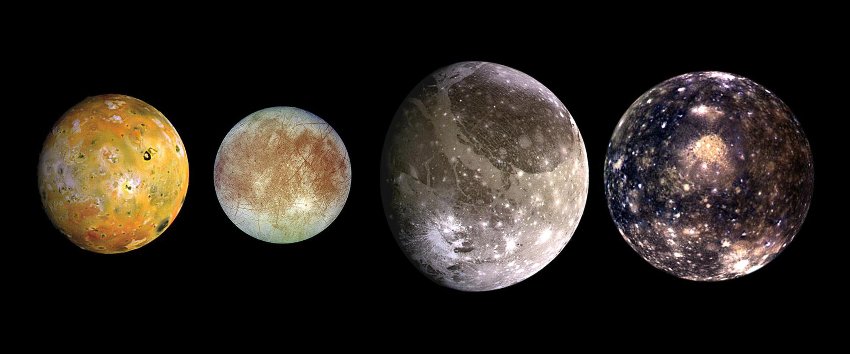
Sept. 28, 2016
Research Highlight
Stabilizing Carbon Dioxide on the Surface of Meteorites
Unlocking clues about the surfaces of jovian and Galilean satellites.
This composite includes the four largest moons of Jupiter which are known as the Galilean satellites. The Galilean satellites were first seen by the Italian astronomer Galileo Galilei in 1610. Shown from left to right in order of increasing distance from Jupiter, Io is closest, followed by Europa, Ganymede, and Callisto. Credit: NASA
Carbon dioxide (CO2) has been identified in non-ice regions on the surface of some of Jupiter’s moons. However, these regions are too warm for CO2 to persist because CO2-ice should quickly sublimate on its own. This means that CO2 ice must be stabilized by a non-ice species. To examine this phenomenon, a team of researchers has studied CO2 gas absorption on the surface of carbonaceous chondrite meteorites in the laboratory. They found that a primitive, minimally altered (CI) meteorite absorbed more CO2 than non-CI meteorites. Additionally, they showed that CO2 had an affinity for complex clays.
Moons of Jupiter, such as Europa and Ganymede, are interesting targets for astrobiology in our solar system. For instance, astrobiologists are currently trying to determine the potential for habitable environments in the sub-ice ocean of Europa. Studying the materials on the surface of such worlds, and how they might be delivered to the underlying ocean, can help scientists understand the potential catalog of materials that life might use in such environments.
The study, “Spectral nature of CO2 adsorption onto meteorites,” was published in the journal Icarus. The research was funded through NASA’s Emerging Worlds program, which supports some projects that investigate science goals of relevance to the NASA Astrobiology Program.
